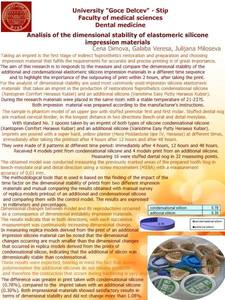Veresa Dimova, Galaba and Dimova, Cena and Miloseva, Julijana (2015) Analysis of the dimensional stability of elastomeric silicone impression materials. In: International Symposium at Faculty of Medical Sciences “Current achievements and future perspectives in medical and biomedical research”, 24 Nov 2015, Stip, Macedonia.
flaer (002) (003).pdf - Published Version
Download (312kB) | Preview
![12270348_1150833041612113_1880471742_n.jpg [thumbnail of 12270348_1150833041612113_1880471742_n.jpg]](https://eprints.ugd.edu.mk/15145/2.hassmallThumbnailVersion/12270348_1150833041612113_1880471742_n.jpg)

12270348_1150833041612113_1880471742_n.jpg - Presentation
Download (81kB) | Preview
Invitation for SYMPOSIUM at FMN 24 11 0215.pdf - Published Version
Download (514kB) | Preview
book of abstracts 02012016.pdf
Download (1MB) | Preview
Abstract
Taking an imprint is the first stage of indirect fix prosthetics restoration and preparation and choosing impression material that fulfils the requirements for accurate and precise printing is of great importance.
The aim of this research is to responds to the measure and compare the dimensional stability of the additional and condensational elastomeric silicon’s impression materials in a different time sequence and to highlight the importance of the outpouring of print within 2 hours, after taking the print.
For the analysis of dimensional stability are used most commonly used silicone impression elastomeric materials that takes an imprint in the production of restorations fix prosthetics condensational silicone (Xantopren Comfort Heraeus Kulzer) and an additional silicone (Variotime Easy Putty Heraeus Kulzer). During the research materials were placed in the same room with a stable temperature of 21-23º. Both impression materials was prepared according to the manufacturer's instructions.
The sample is phantom model of an upper jaw with stuffed first premolar and first molar. Stuffed dental nog are marked cervical border, in the longest distance in two directions buccal-oral and distal-mesial. With standard No. 3 spoons taken by an imprint of both types of silicone condensational silicone (Xantopren Comfort Heraeus Kulzer) and an additional silicone (Variotime Easy Putty Heraeus Kulzer). Imprints are poured with a super hard, yellow plaster (Hera Moldastone tipe IV, Heraeus) at different time’s sequence.
They were made of 8 patterns at different time period: immediately after 4 hours, 12 hours and 48 hours. Received 4 models print from condensational silicone and 4 models print from an additional silicone. Were measuring 16 stuffed dental nog in 32 measuring points.
The obtained model was conducted measuring the previously marked areas of the prepared tooth nog using a screw micrometers (MEBA) with a measurement accuracy of 0,01 mm.
The methodological tools that is used is based on the finding of the impact of the time factor on the dimensional stability of prints from two different impression materials and mutual comparing the results obtained with manual survey of replica models printout of an additional and condensational silicone and comparing them with the control model. The results are expressed in millimeters and percentages.
Dimensional changes between model and its reproductions occurred as a consequence of dimensional instability impression material. The results indicate that in both directions, with each successive measurement was continuously increasing dimensional change. In measuring replica models derived from the print of an additional impression silicone material can be noted that the dimensional changes occurring are much smaller than the dimensional changes that occurred in replica models derived from the prints of condensational silicon, indicating that the additional of silicon was dimensionally stable than condensational.
Dimensional changes between the model and its reproductions resulted from the dimensional instability impression material. The difference was greater in print taken with condensation silicone (0.78%), compared to the imprint taken with an additional silicone (0.30%).
Both impressional materials showed satisfactory results in terms of dimensional stability and did not change more than 1.08%.
Keywords
dimensional changes, impression material, print, phantom model restoration.
| Item Type: | Conference or Workshop Item (Poster) |
|---|---|
| Subjects: | Medical and Health Sciences > Basic medicine Medical and Health Sciences > Clinical medicine Medical and Health Sciences > Health sciences Medical and Health Sciences > Other medical sciences |
| Divisions: | Faculty of Medical Science |
| Depositing User: | Cena Dimova |
| Date Deposited: | 28 Jan 2016 10:20 |
| Last Modified: | 28 Jan 2016 10:20 |
| URI: | https://eprints.ugd.edu.mk/id/eprint/15145 |
